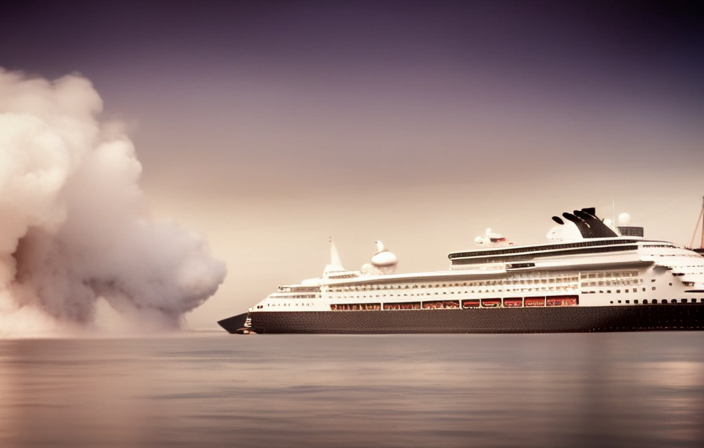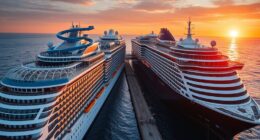Have you ever thought about the significant amount of fuel required to operate a large cruise ship? Prepare to be astonished because the figures are remarkably high. As a travel enthusiast and a dedicated environmental advocate, I explored the realm of fuel usage on cruise ships to reveal the realities of this massive industry.
In this article, we will explore the environmental impact of cruise ships and the factors that affect their fuel consumption. We will dive into the various ways these floating cities are powered and examine the average fuel consumption per mile.
Additionally, we’ll discuss strategies that can be implemented to reduce fuel consumption and the unexpected impact of the COVID-19 pandemic on this industry. Furthermore, we will analyze public perception and consumer demand, as well as the role of government and international organizations in regulating fuel consumption.
By the end, we will have a comprehensive understanding of how cruise ships can balance the pleasure of cruising with environmental responsibility.
Key Takeaways
- Cruise companies are transitioning to sustainable practices and exploring green technology and alternative fuels.
- The COVID-19 pandemic has temporarily reduced fuel consumption and emissions in the cruise industry.
- Optimizing fuel consumption involves strategies such as reducing fuel usage, optimizing ship speed and route planning, and considering weather conditions and currents.
- The cruise industry is exploring the use of alternative fuels like liquefied natural gas and biofuels, and investing in technological advancements in propulsion systems.
The Environmental Impact of Cruise Ships
The environmental impact of cruise ships can’t be ignored, as they consume copious amounts of fuel per mile traveled. Funding initiatives have been established to address this issue and promote sustainable practices within the cruise industry.
One such initiative is the Cruise Ship Waste Management program, which aims to minimize the disposal of waste materials and pollutants into the ocean. By implementing advanced technologies and practices, cruise ships can reduce their carbon footprint and mitigate the negative effects on marine ecosystems.
Additionally, funding is allocated towards research and development of alternative fuel sources, such as biofuels or hydrogen, which could significantly decrease fuel consumption and emissions. Understanding the factors affecting fuel consumption, such as ship design, speed, and route optimization, is crucial in further improving the environmental performance of cruise ships.
Factors Affecting Fuel Consumption
One key factor that impacts a cruise ship’s fuel consumption is the distance it travels. The longer the distance, the more fuel the ship will consume.
However, there are several other factors that also play a role in fuel consumption. These include the ship’s size and weight, the speed at which it travels, and the weather conditions it encounters.
Larger and heavier ships require more fuel to move through the water, while higher speeds result in increased fuel consumption. Additionally, adverse weather conditions such as strong winds or rough seas can also affect fuel efficiency.
To mitigate the impact of these factors, cruise ships employ various strategies such as optimizing routes, using advanced navigation systems, and implementing energy-saving technologies. These strategies aim to reduce fuel consumption and minimize the environmental footprint of cruise ships.
In the subsequent section, we will explore how cruise ships are powered.
How Cruise Ships are Powered
When discussing how cruise ships are powered, it’s important to consider the use of traditional fuels versus alternative energy sources.
This is a key point in understanding the environmental impact of cruise ships and their emissions.
Additionally, the role of liquefied natural gas (LNG) can’t be overlooked in reducing emissions, as it’s becoming an increasingly popular and cleaner fuel option for cruise ships.
Traditional Fuels vs. Alternative Energy Sources
In comparing traditional fuels to alternative energy sources, it’s important to consider the amount of fuel a cruise ship uses per mile. When it comes to alternative fuel options, there are several to consider.
However, the decision to switch from traditional fuels to alternative energy sources must also take into account the cost implications. While alternative energy sources such as liquefied natural gas (LNG) may offer lower emissions, they can come with higher upfront costs and infrastructure requirements.
It is crucial for cruise ship operators to carefully evaluate the long-term benefits and drawbacks of each alternative fuel option, weighing them against the current fuel consumption rates. This analysis will help determine the feasibility and potential impact of transitioning to alternative energy sources.
Considering these factors, the role of LNG in reducing emissions becomes a significant aspect to explore further.
The Role of LNG in Reducing Emissions
The implementation of liquefied natural gas (LNG) as an alternative fuel source presents a compelling opportunity for reducing emissions in the cruise industry.
Here are three key points to consider when comparing LNG to traditional diesel fuel:
-
Lower Emissions: LNG produces significantly fewer emissions compared to diesel, including sulfur oxides (SOx), nitrogen oxides (NOx), and particulate matter. This makes it a cleaner and more environmentally friendly option for powering cruise ships.
-
Infrastructure Development: While LNG infrastructure is still developing, it has been steadily growing in recent years. Ports and terminals are investing in LNG bunkering facilities, allowing cruise ships to refuel with LNG and reduce their carbon footprint.
-
Cost Considerations: While the initial investment in LNG infrastructure may be higher, the long-term operational costs of using LNG can be lower. As the demand for LNG increases, prices are expected to become more competitive, making it a viable and cost-effective alternative to traditional fuels.
Transitioning to the next section, let’s now explore the average fuel consumption per mile of cruise ships.
Average Fuel Consumption per Mile
Cruise ships typically consume a significant amount of fuel per mile traveled. The average fuel efficiency of a cruise ship can vary depending on several factors, such as the ship’s size, speed, and design. However, fuel saving techniques have been implemented to improve efficiency and reduce consumption.
These techniques include optimizing the ship’s route to minimize distances, utilizing advanced propulsion systems, and implementing energy-saving technologies. By implementing these measures, cruise ships can achieve higher fuel efficiency, resulting in reduced fuel consumption per mile.
In the subsequent section, we’ll explore strategies to further reduce fuel consumption, including the use of alternative fuels and technologies. Transitioning into this section, it’s essential to consider additional measures that can be taken to achieve even greater fuel efficiency.
Strategies to Reduce Fuel Consumption
One effective way to cut down on the amount of fuel a ship consumes for each mile traveled is by implementing innovative strategies for fuel efficiency.
Cruise ships have been exploring various technological advancements to reduce their fuel consumption and minimize their environmental impact. These strategies include optimizing ship design to reduce drag, improving engine efficiency, and utilizing alternative fuels such as liquefied natural gas (LNG).
Additionally, cruise lines are investing in advanced monitoring systems to accurately track fuel consumption and identify areas for improvement. By adopting these strategies, cruise ships can significantly reduce their fuel consumption per mile, leading to a more sustainable and environmentally friendly operation.
Looking ahead, the future of sustainable cruising will involve further advancements in technology and the continued pursuit of fuel efficiency to minimize the industry’s carbon footprint.
The Future of Sustainable Cruising
Imagine sailing on a luxurious vessel that seamlessly combines cutting-edge technology and sustainable practices, offering you an unforgettable experience while minimizing its environmental impact.
The future of sustainable cruising holds great promise, as the industry continues to embrace innovative solutions and sustainable practices. Cruise lines are investing in advanced technologies to reduce fuel consumption, such as using cleaner fuels, optimizing ship design for greater efficiency, and implementing energy-saving measures on board.
Additionally, alternative energy sources like liquefied natural gas (LNG) and hybrid propulsion systems are being explored to further reduce emissions. These future innovations will not only enhance the guest experience but also contribute to a more sustainable future for the cruise industry.
As we transition to the subsequent section about the impact of covid-19 on cruise ship fuel consumption, it is important to analyze how these sustainable practices will play a role in the industry’s recovery and resilience.
The Impact of COVID-19 on Cruise Ship Fuel Consumption
The impact of COVID-19 on cruise ship fuel consumption has led to temporary reductions in emissions and significant changes in industry practices.
As a result of the pandemic, cruise ships have been forced to suspend operations, leading to a decrease in fuel consumption and subsequent emissions.
This temporary reduction in emissions provides an opportunity for the industry to evaluate its practices and explore more sustainable options for the future.
Temporary Reductions in Emissions
Reduce emissions temporarily by using less fuel on a cruise ship, which can significantly decrease the environmental impact per mile traveled. Implementing temporary measures and short-term solutions can be an effective strategy to achieve this goal.
One approach is to optimize the ship’s speed and route planning, taking into account factors such as weather conditions and currents to minimize fuel consumption. Another option is to use alternative fuels, such as liquefied natural gas or biofuels, which produce fewer greenhouse gas emissions compared to traditional marine fuels.
Additionally, improving energy efficiency onboard through technological advancements and operational practices can further reduce fuel usage. These temporary reductions in emissions provide valuable insights into the feasibility and effectiveness of various strategies, paving the way for long-term changes in industry practices.
By implementing these measures, cruise ships can navigate towards a more sustainable future, mitigating their environmental impact without compromising travel experiences.
Long-Term Effects on Industry Practices
By implementing sustainable measures, the cruise industry can pave the way for long-term changes in their practices, creating a more environmentally conscious future. These changes have significant long-term economic implications for the industry. While initial investments in green technology and alternative fuels may be costly, they can lead to substantial savings in fuel consumption and operational costs over time. Additionally, technological advancements in propulsion systems, such as the use of liquefied natural gas (LNG) and electric power, are making it possible to reduce emissions and fuel consumption even further. The industry must embrace these advancements and invest in research and development to stay ahead of environmental regulations and consumer expectations. This shift towards sustainability will not only benefit the environment but also enhance the industry’s reputation and meet the growing consumer demand for greener travel options. Transitioning into the subsequent section about ‘public perception and consumer demand’, it is crucial for the cruise industry to understand the impact of their practices on public opinion and adapt accordingly.
Public Perception and Consumer Demand
Imagine how much more appealing cruise ship vacations would become if you knew exactly how fuel-efficient they were per mile. Public perception plays a significant role in shaping consumer behavior, and the demand for more sustainable options is steadily increasing.
As consumers become more environmentally conscious, they’re actively seeking out travel options that have a smaller carbon footprint. This shift in public perception has prompted cruise companies to invest in more fuel-efficient technologies and practices. Consumers now have the power to influence industry practices by choosing cruise lines that prioritize sustainability.
However, consumer demand alone may not be enough to drive lasting change. The role of government and international organizations is crucial in setting regulations and standards that enforce fuel efficiency and emission reduction in the cruise industry.
The Role of Government and International Organizations
To truly navigate the rough waters of sustainability, you need the guiding hand of government and international organizations.
Government regulations play a crucial role in ensuring that cruise ships adhere to environmental standards. These regulations set limits on emissions, waste disposal, and fuel consumption, helping to minimize the environmental impact of these massive vessels.
Additionally, international cooperation is vital in addressing the global nature of cruise ship emissions. Collaboration between countries allows for the development of common standards and guidelines, ensuring that cruise ships operate responsibly regardless of their location.
By working together, governments and international organizations can create a framework that promotes sustainability in the cruise industry. This collaboration is essential to protect our oceans and the delicate ecosystems they support.
Transitioning into the subsequent section about ‘conclusion: balancing the pleasure of cruising with environmental responsibility’, it’s clear that government and international organizations play a critical role in shaping the future of sustainable cruising.
Conclusion: Balancing the Pleasure of Cruising with Environmental Responsibility
Finding a balance between the enjoyment of cruising and the need for environmental responsibility is crucial for the sustainable future of the industry. As discussed in the previous sections, the role of government and international organizations is vital in regulating and enforcing environmental standards for cruise ships. However, it is equally important for cruise companies themselves to take proactive measures in reducing their environmental footprint.
One way cruise companies can achieve this balance is by investing in fuel-efficient technologies. By using cleaner fuels and adopting energy-saving practices, such as optimizing engine performance and reducing onboard energy consumption, cruise ships can significantly reduce their fuel consumption and emissions. Additionally, implementing waste management systems and recycling programs can further minimize the negative impact on the environment.
To illustrate the importance of balancing pleasure and environmental responsibility, consider the following table:
| Balancing Pleasure | Environmental Responsibility |
|---|---|
| Luxurious amenities | Fuel-efficient engines |
| Exquisite dining | Waste management systems |
| Entertainment | Recycling programs |
In conclusion, finding the right balance between the pleasure of cruising and environmental responsibility requires a multi-faceted approach involving both regulatory measures and voluntary actions by cruise companies. By working together, we can ensure that the enjoyment of cruising is not compromised while minimizing the industry’s impact on the environment.
Frequently Asked Questions
How does the size of a cruise ship affect its fuel consumption per mile?
The size of a cruise ship has a significant impact on its fuel consumption per mile. Larger ships tend to have better fuel efficiency due to advancements in engine technology and streamlined designs.
Are there any regulations in place to limit the fuel consumption of cruise ships?
There are regulations in place to limit the fuel consumption of cruise ships due to the environmental impact. These regulations aim to reduce emissions, promote fuel efficiency, and encourage the use of cleaner fuels.
What are the most common alternative fuels used by cruise ships to reduce their environmental impact?
The most common alternative fuel options for cruise ships to reduce environmental impact include liquefied natural gas (LNG) and marine gas oil (MGO). These options offer benefits such as lower emissions, improved air quality, and reduced carbon footprint.
How do weather conditions, such as wind speed and sea currents, affect a cruise ship’s fuel consumption?
The impact of ocean currents and wind speed on cruise ship fuel usage is significant. Ocean currents can either assist or hinder the ship’s movement, while wind speed affects the ship’s resistance. Both factors can greatly influence fuel consumption.
Are there any technological advancements being made to improve the fuel efficiency of cruise ships in the future?
Innovative solutions and green technologies are being developed to improve the fuel efficiency of cruise ships in the future. These advancements aim to reduce fuel consumption and emissions, promoting environmental sustainability in the industry.
Conclusion
In conclusion, the fuel consumption of cruise ships is a pressing environmental concern that requires immediate attention.
As I delved into the topic, I was astonished to discover that a single cruise ship can consume up to 150 tons of fuel per day, equivalent to the weight of 30 elephants! This staggering metaphor highlights the immense impact of these vessels on our planet.
It’s crucial for the cruise industry to adopt strategies to reduce fuel consumption and prioritize environmental responsibility. Only through collective efforts can we navigate towards a more sustainable future.










